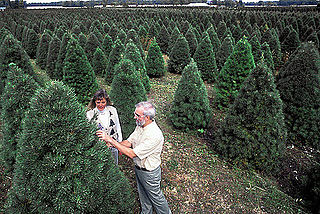 W
WChristmas tree production occurs worldwide on Christmas tree farms, in artificial tree factories and from native strands of pine and fir trees. Christmas trees, pine and fir trees purposely grown for use as a Christmas tree, are grown on plantations in many western nations, including Australia, the United Kingdom and the United States. In Australia, the industry is relatively new, and nations such as the United States, Germany and Canada are among world leaders in annual production.
 W
WThe British Christmas Tree Growers Association is the trade association for those who grow specialist Christmas Trees in Great Britain and Northern Ireland. Membership is open to those who intend to grow or are growing trees for the Christmas market. Associate membership is available for those who provide goods and services to the Christmas Tree sector.
 W
WChristmas tree production in Canada totals from 3 to 6 million trees annually. Trees are produced in many of the provinces of Canada but the nation's leading producers are found in Quebec, Nova Scotia and Ontario, which account for 80 percent of Canadian tree production. Of the 900,000 trees produced annually in British Columbia, most are cut from native pine stands.
 W
WThe Christmas Tree Ship is the second EP by I Like Trains. It was released on 24 November 2008.
 W
WChristmas tree cultivation is an agricultural, forestry, and horticultural occupation which involves growing pine, spruce, and fir trees specifically for use as Christmas trees.
 W
WSources of the National Christmas Tree in the United States have varied over time. The first National Christmas Tree was erected and lit by President Calvin Coolidge in 1923. As of 2011, the tradition has continued uninterrupted. The trees have come from a wide variety of sources, were placed or planted in different places on the grounds of the President's Park or the White House, have varied in height, and have sometimes been a cut tree and sometimes a living planted tree.
 W
WPine and fir trees, grown purposely for use as Christmas trees, are vulnerable to a wide variety of pests, weeds and diseases. Many of the conifer species cultivated face infestations and death from such pests as the balsam woolly adelgid and other adelgids. Aphids are another common insect pest. Christmas trees are also vulnerable to fungal pathogens and their resultant illnesses such as root rot, and, in the U.S. state of California, sudden oak death. Douglas-fir trees in particular are vulnerable to infections from plant pathogens such as R. pseudotsugae.
 W
WThe Propagation of Christmas trees is the series of procedures carried out to grow new Christmas trees.
 W
WThe Rouse Simmons was a three-masted schooner famous for having sunk in a violent storm on Lake Michigan in 1912. The ship was bound for Chicago with a cargo of Christmas trees when it foundered off Two Rivers, Wisconsin, killing all on board.
 W
WA tree baler is a machine that wraps trees to allow for easier shipment and storage. Wrapped trees take up much less space and are less likely to be damaged during shipment. The aim of the device is to replace work that previously required hand-tying individual trees, most often used at commercial nurseries.
 W
WWhile the first Christmas tree farm may have appeared as early as 1901, Christmas tree production in the United States was largely limited to what could be harvested from natural forests until the 1950s. Among the important Christmas tree producing areas in the U.S. are Wisconsin, North Carolina, Pennsylvania and the Pacific Northwest. In 2002 Christmas tree production in the United States totaled 20.8 million trees and the U.S. was one of the world's leading producers of natural Christmas trees. That same year, Pennsylvania was the top producer in the United States.